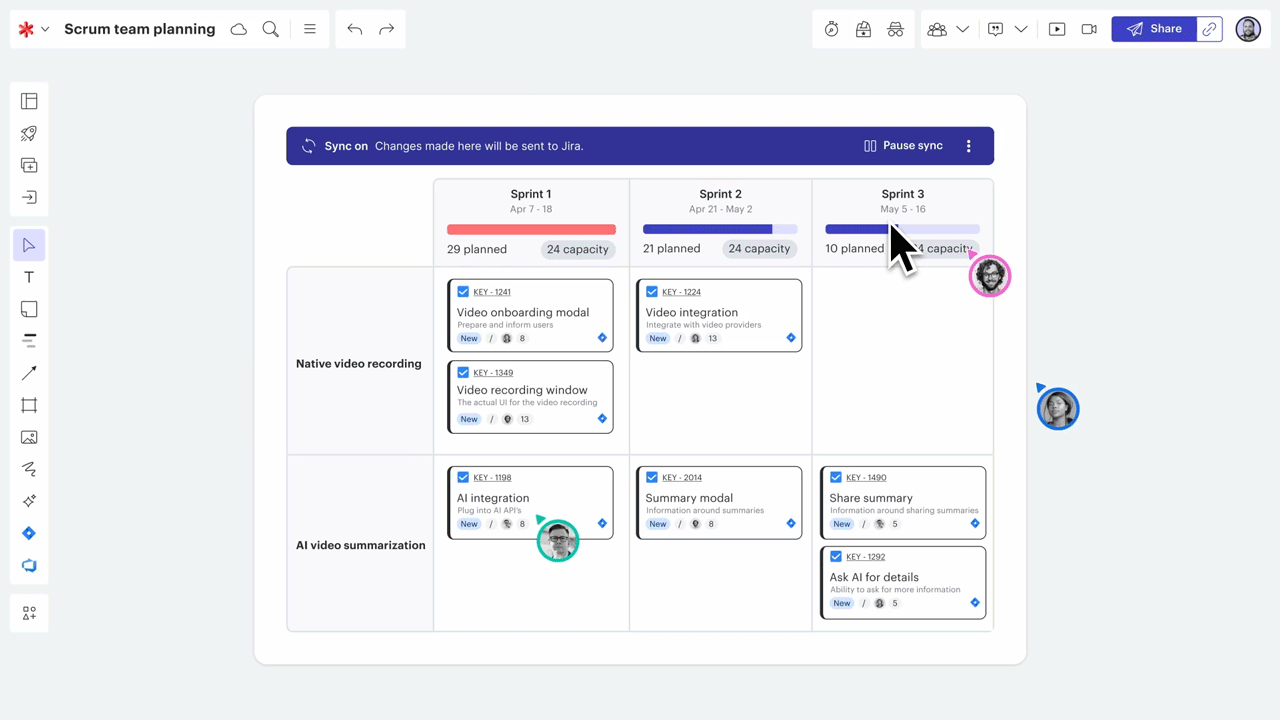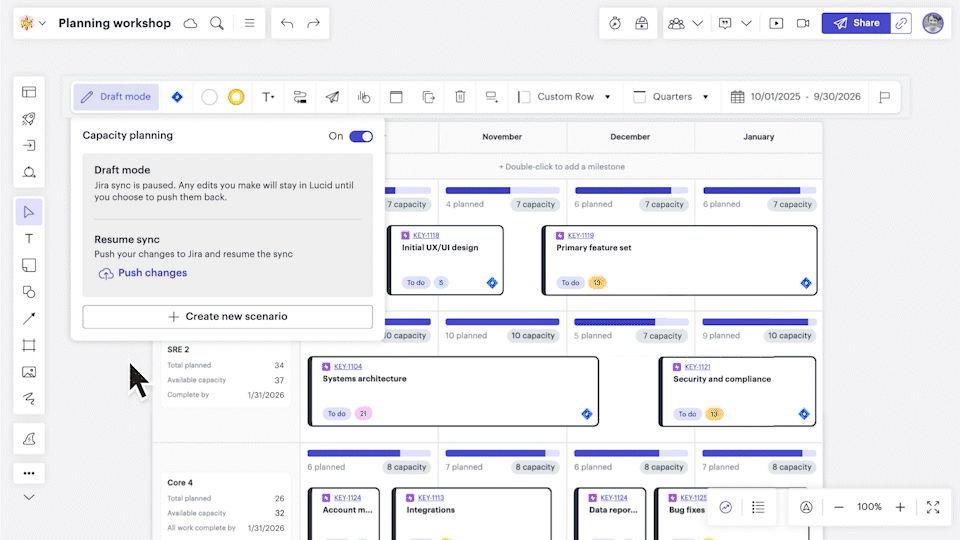
All about the business scenario planning process
Christopher Bailey
Reading time: about 8 min
Topics:
Key takeaways
-
Scenario planning informs business strategy by helping companies anticipate and prepare for multiple scenarios that may happen in the future.
-
Scenario planning helps businesses identify risks, manage uncertainty, become more resilient, and maintain a competitive advantage.
-
Visualizing scenarios helps to more effectively assess and compare potential outcomes, making it easier to plan strategies accordingly.
It doesn’t matter how advanced science gets—it’s impossible to predict the future accurately.
Similarly, in business, you can’t predict exactly what will happen with your company, its products, or the industry you work in. However, you can use past experiences and data analytics to predict what might happen in the future and make a plan for it. And that is essentially what scenario planning is.
What is scenario planning in business?
Scenario planning is an effective management tool that can help you anticipate and prepare for multiple possible scenarios. It is used to develop a business strategy that includes:
-
What might happen based on various factors and events, such as changing market conditions or technological advancements
-
The potential challenges and complications that might arise from those events
-
The exploration of possible opportunities associated with various scenarios
-
Plans and strategies to address each scenario
Why is scenario planning important?
Scenario planning encourages team leaders to be more proactive and creative when approaching their plans. It helps you to:
-
Manage an uncertain future.
-
Identify risks, challenges, and possible opportunities so you can make strategic decisions that align with your company’s long-term goals.
-
Identify gaps, which can give you new insight into potential risks and disruptions.
-
Be more adaptable and resilient with flexible strategies and contingency plans that address a variety of possible scenarios.
-
Encourage a collaborative environment by working more closely with and seeking input from cross-functional teams and stakeholders.
-
Have a competitive advantage because you can make decisions and react quickly to changing situations.
Scenario planning vs. forecasting
Scenario planning and forecasting are both approaches to preparing for and understanding the future. Sometimes these terms are used interchangeably, but there are key differences.
Forecasting
Forecasting is a predictive process that typically focuses on a single, probable future. The main question is, “What will happen?”
As you complete forecasting, you’ll:
-
Study established trends and measurable, quantitative data.
-
Focus on short-term timeframes (typically within the next year or quarter).
-
Assume that the future will mainly resemble the past.
The ultimate goal of forecasting is to accurately inform operational planning and resource allocation, such as budgeting.
Scenario planning
Scenario planning, on the other hand, is a more exploratory process that considers multiple possible futures. It asks, “What might happen?”
As you conduct scenario planning, you’ll:
-
Study qualitative data and uncertainties, such as potential disruptive forces.
-
Focus on long-term timeframes (typically over multiple years).
-
Assume that the future will be significantly different than the past.
Scenario planning is more helpful for companies navigating uncertain times or volatile environments. Overall, the goal is to challenge assumptions, build resilience, and enhance flexibility as teams understand potential risks and develop strategies to adapt.
Types of scenario planning
Depending on your specific needs and objectives, you can use several different scenario planning approaches. These include:
-
Normative scenarios: Normative scenario planning focuses on developing a preferred future or the ideal end state that the company wants. For example, maybe your business wants to increase revenue by 30% within the next four years. Normative planning involves creating scenarios that could guide your company toward that 30% revenue increase goal.
-
Operational scenarios: This type of scenario planning focuses on events and the possible impact these events will have on your business. It involves developing scenarios that address your organization's specific operational processes to deliver products and services—for example, what your business would do if your supply chain were disrupted. Analyzing the effects of these processes and events can help you improve operational processes by considering possible future situations.
-
Quantitative scenarios: This approach uses quantitative analysis and modeling to help you predict and understand possible scenarios. You use data, numbers, and mathematical models to describe plausible scenarios, the probability that these scenarios will occur, and the potential impact they will have. Quantitative scenario planning is often used to develop annual business forecasts.
-
Strategic management scenarios: These scenarios guide an organization's strategic decision-making process. These scenarios primarily focus on the environment where your products are consumed. For example, strategic management scenarios for a car manufacturer might focus on what the introduction of electric vehicles means for customers who own trucks. This type of planning can help you to develop scenarios that address long-term strategies centered around your organization’s goals, capabilities, and competitive positioning.
The scenario planning process
The scenario planning process typically includes the following steps.
Step 1: Identify key issues, trends, and driving forces
Determine what you want to focus on as you develop your scenarios. What are the driving forces (or variables) to consider that might have an impact on the way you do business?
Are there emerging technologies, such as AI, that are making a significant impact on how customers use your product? Do you operate in a particularly uncertain industry that’s dependent on a specialized supply chain? Take some time to first understand the trends and uncertainties that lead to multiple possible outcomes for your company.
Customizable templates help you identify potential variables and kick-start discussions about the factors that may have an impact on your business down the line. For example, a SWOT analysis is an effective way to examine potential situations and opportunities.

Once you’ve identified issues and trends, you can begin developing potential scenarios that showcase what might happen if these factors actually come into play.
Step 2: Develop and visualize plausible scenarios
Develop multiple distinct and plausible scenarios that describe the possible futures related to your selected driving forces. But don’t go overboard—try to focus on two or three significant uncertainties for developing your scenarios.
For example, if you are evaluating scenarios around how implementing the use of AI might affect your business, ask questions such as:
-
How can AI initiatives help us gain a competitive advantage and achieve business goals? Will we be able to keep up with the pace of change?
-
Can AI be used to increase productivity, automate tasks, or optimize processes?
-
How will existing workflows change if the business adopts the use of AI among employees?
-
How will we ensure legal compliance surrounding AI data management?
It’s helpful to explore your scenarios on a visual canvas so you can actually see how potential changes impact business outcomes.
With Lucid’s Agility Accelerator, for instance, you can use enhanced planning features to visualize how different factors, such as a change to scope, impact your business. In Lucid, you can explore multiple scenarios in draft mode, which pauses the two-way sync between Lucid and your existing system of record, such as Jira, Azure DevOps, or airfocus. This way, any changes you make to your plan in Lucid won’t disrupt your existing record. When you are ready to apply changes, simply switch off draft mode and re-enable automatic syncing.

With Lucid, you can develop and visualize multiple possible scenarios on the same canvas to understand risks and plan strategies accordingly. Assess and compare each scenario for opportunities, challenges, and the requirements of each possible future. Identify the actions you want to take based on your assessment of identified scenarios.

Visualizing and evaluating your scenarios helps you choose which strategies to implement.
Step 3: Monitor and update strategies
Scenario planning is not a one-and-done activity. After you put the strategies you’ve identified into action, it’s important to revisit your scenarios and assess them again in the future as you gather new information. Are your strategies working, or do you need new ones?
By using Lucid’s scenario planning feature, you can create a single source of truth that keeps everyone aligned as you implement your selected strategies. And, it’s easy to revisit your board and make adjustments when it’s time to conduct scenario planning again.
While there’s not a general rule of thumb for how frequently you should do the scenario planning process, let the factors you’re assessing be your guide. Some companies plan for scenarios that are 30-50 years ahead, with a review every 5-10 years. If your business landscape changes more often, scenario planning may need to be done annually or even quarterly.
As you run through scenarios, pick a time horizon to revisit your planning, based on when you anticipate meaningful changes to occur. It depends on the factors you’ve identified, but remember this: Like most techniques that help you work more efficiently, scenario planning is an ongoing process that includes frequent refinement and adaptation.
Lucid helps you conduct effective scenario planning for your business
Scenario planning is extremely helpful for strategic decision-making and developing resiliency for any business. With the enhanced planning capabilities in Lucid’s Agility Accelerator, it’s easy to create multiple scenarios, understand the impact of certain factors, and work toward your ideal future state.
And that’s not all—businesses use Lucid for capacity planning, dependency mapping, visualizing product backlogs, and more. Check out the ways that you can use Lucid to enhance agility across your organization and prepare teams to adapt to changes at work.

How Lucid enhances agility
Learn how Lucid’s unique features and capabilities boost alignment and communication.
Read moreAbout the author

Christopher Bailey, director of consulting services for Lucid, helps people see and build the future using a combination of the Lucid Visual Collaboration Suite and his nearly 20 years of industry experience. Bailey has led initiatives to develop innovation pipelines, transform teams to an Agile system of delivery, and develop new products. Bailey has a Master's of Information Systems Management from Brigham Young University and a crazy, geeky family with a brilliant wife, three silly boys, and a firecracker of a daughter.
About Lucid
Lucid Software is the leader in visual collaboration and work acceleration, helping teams see and build the future by turning ideas into reality. Its products include the Lucid Visual Collaboration Suite (Lucidchart and Lucidspark) and airfocus. The Lucid Visual Collaboration Suite, combined with powerful accelerators for business agility, cloud, and process transformation, empowers organizations to streamline work, foster alignment, and drive business transformation at scale. airfocus, an AI-powered product management and roadmapping platform, extends these capabilities by helping teams prioritize work, define product strategy, and align execution with business goals. The most used work acceleration platform by the Fortune 500, Lucid's solutions are trusted by more than 100 million users across enterprises worldwide, including Google, GE, and NBC Universal. Lucid partners with leaders such as Google, Atlassian, and Microsoft, and has received numerous awards for its products, growth, and workplace culture.
Related articles
The pitfalls of strategic planning (and how to overcome them)
Strategic planning is no easy task. Here are some common pitfalls and how to beat the odds and execute strategic plans to shape your organization's future.
How to develop a business strategy [+ free templates]
Learn how to develop a business strategy for your organization. We’ve also included free templates to help you start.
How visual collaboration strengthens operational resilience
Learn what operational resilience is, the struggles organizations currently face, and how visual collaboration can strengthen operational resilience.
What is capacity planning? A step-by-step breakdown + best practices
Learn how to do capacity planning effectively with your team.
